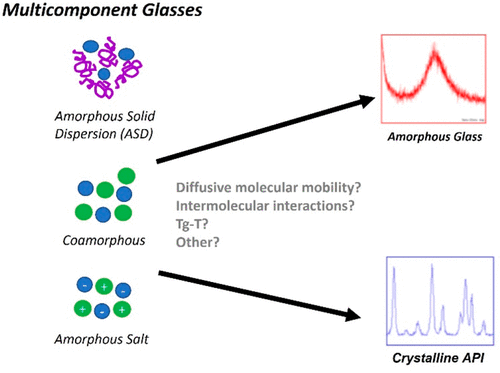当前位置:
X-MOL 学术
›
Mol. Pharmaceutics
›
论文详情
Our official English website, www.x-mol.net, welcomes your
feedback! (Note: you will need to create a separate account there.)
What Are the Important Factors That Influence API Crystallization in Miscible Amorphous API–Excipient Mixtures during Long-Term Storage in the Glassy State?
Molecular Pharmaceutics ( IF 4.5 ) Pub Date : 2021-08-11 , DOI: 10.1021/acs.molpharmaceut.1c00519 Ann Newman 1 , George Zografi 2
Molecular Pharmaceutics ( IF 4.5 ) Pub Date : 2021-08-11 , DOI: 10.1021/acs.molpharmaceut.1c00519 Ann Newman 1 , George Zografi 2
Affiliation

|
In this Perspective, the authors examine the various factors that should be considered when attempting to use miscible amorphous API–excipient mixtures (amorphous solid dispersions and coamorphous systems) to prevent the solid-state crystallization of API molecules when isothermally stored for long periods of time (a year or more) in the glassy state. After presenting an overview of a variety of studies designed to obtain a better understanding of possible mechanisms by which amorphous API undergo physical instability and by which excipients generally appear to inhibit API crystallization from the amorphous state, we examined 78 studies that reported acceptable physical stability of such systems, stored below Tg under “dry” conditions for one year or more. These results were examined more closely in terms of two major contributing factors: the degree to which a reduction in diffusional molecular mobility and API–excipient molecular interactions operates to inhibit crystallization. These two parameters were chosen because the data are readily available in early development to help compare amorphous systems. Since Tg – T = 50 K is often used as a rule of thumb for the establishing the minimum value below Tg required to reduce diffusional mobility to a period of years, it was interesting to observe that 30 of the 78 studies still produced significant physical stability at values of Tg – T < 50 K (3–47 °C), suggesting that factors besides diffusive molecular mobility likely contribute. A closer look at the Tg – T < 50 systems shows that hydrogen bonding, proton transfer, disruption of API–API self-associations (such as dimers), and possible π–π stacking were reported for most of the systems. In contrast, five crystallized systems that were monitored for a year or more were also examined. These systems exhibited Tg – T values of 9–79, with three of them exhibiting Tg – T < 50. For these three samples, none displayed molecular interactions by infrared spectroscopy. A discussion on the impact of relative humidity on long-term crystallization in the glass was included, with attention paid to the relative water vapor sorption by various excipients and effects on diffusive mobility and molecular interactions between API and excipient.
中文翻译:

在玻璃态下长期储存期间,影响混溶无定形 API-赋形剂混合物中 API 结晶的重要因素是什么?
在这篇观点中,作者研究了在尝试使用可混溶的无定形 API-赋形剂混合物(无定形固体分散体和无定形系统)以防止 API 分子在等温长时间储存时发生固态结晶时应考虑的各种因素(一年或更长时间)处于玻璃状状态。在概述了旨在更好地了解无定形 API 经历物理不稳定性和赋形剂通常似乎抑制 API 从无定形状态结晶的可能机制的各种研究之后,我们审查了 78 项报告了可接受的物理稳定性的研究。此类系统,存储在T g以下在“干燥”条件下一年或更长时间。根据两个主要影响因素更仔细地检查了这些结果:扩散分子迁移率的降低和 API-赋形剂分子相互作用抑制结晶的程度。选择这两个参数是因为数据在早期开发中很容易获得,以帮助比较无定形系统。由于T g – T = 50 K 通常被用作建立低于T g所需的最小值以将扩散迁移率降低到几年的经验法则,有趣的是观察到 78 项研究中的 30 项仍然产生了显着T g – T值下的物理稳定性< 50 K (3–47 °C),表明除扩散分子迁移率之外的其他因素可能也有贡献。仔细观察T g - T < 50 系统表明,大多数系统都报告了氢键、质子转移、API-API 自缔合(如二聚体)的破坏以及可能的 π-π 堆叠。相比之下,还检查了监测一年或更长时间的五个结晶系统。这些系统的T g – T值为 9-79,其中三个系统的T g – T< 50. 对于这三个样品,没有一个通过红外光谱显示出分子相互作用。讨论了相对湿度对玻璃中长期结晶的影响,注意各种赋形剂对水蒸气的相对吸附以及对 API 和赋形剂之间的扩散迁移率和分子相互作用的影响。
更新日期:2021-08-11
中文翻译:

在玻璃态下长期储存期间,影响混溶无定形 API-赋形剂混合物中 API 结晶的重要因素是什么?
在这篇观点中,作者研究了在尝试使用可混溶的无定形 API-赋形剂混合物(无定形固体分散体和无定形系统)以防止 API 分子在等温长时间储存时发生固态结晶时应考虑的各种因素(一年或更长时间)处于玻璃状状态。在概述了旨在更好地了解无定形 API 经历物理不稳定性和赋形剂通常似乎抑制 API 从无定形状态结晶的可能机制的各种研究之后,我们审查了 78 项报告了可接受的物理稳定性的研究。此类系统,存储在T g以下在“干燥”条件下一年或更长时间。根据两个主要影响因素更仔细地检查了这些结果:扩散分子迁移率的降低和 API-赋形剂分子相互作用抑制结晶的程度。选择这两个参数是因为数据在早期开发中很容易获得,以帮助比较无定形系统。由于T g – T = 50 K 通常被用作建立低于T g所需的最小值以将扩散迁移率降低到几年的经验法则,有趣的是观察到 78 项研究中的 30 项仍然产生了显着T g – T值下的物理稳定性< 50 K (3–47 °C),表明除扩散分子迁移率之外的其他因素可能也有贡献。仔细观察T g - T < 50 系统表明,大多数系统都报告了氢键、质子转移、API-API 自缔合(如二聚体)的破坏以及可能的 π-π 堆叠。相比之下,还检查了监测一年或更长时间的五个结晶系统。这些系统的T g – T值为 9-79,其中三个系统的T g – T< 50. 对于这三个样品,没有一个通过红外光谱显示出分子相互作用。讨论了相对湿度对玻璃中长期结晶的影响,注意各种赋形剂对水蒸气的相对吸附以及对 API 和赋形剂之间的扩散迁移率和分子相互作用的影响。











































 京公网安备 11010802027423号
京公网安备 11010802027423号